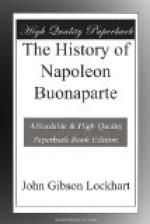Instead, therefore, of sending messengers of peace to Chatillon, Napoleon now thought only of the means of at once holding Schwartzenberg in check on the Seine, and returning once more to confront Blucher on the Marne. He pushed on, however, as far as Troyes, in the expectation of still terrifying the allied princes into some compromise. In this city he found that certain gentlemen had openly assumed the white cockade, the mark of the Bourbonists, during its occupation by the enemy, though without any countenance from the sovereigns. One of these gentlemen was so unfortunate as to fall into his hands, and was immediately executed.
The Emperor in vain expected new proposals from Chatillon; none such reached him at Troyes—and he recurred to his scheme of a second “Expedition of the Marne.” He desired Oudinot and Macdonald, with their divisions, to manoeuvre in the direction of Schwartzenberg: and these generals commanded their troops to shout “vive l’Empereur” whenever they were within hearing of the enemy, which for a little time kept up the notion that Napoleon himself was still advancing on the road to Bar. Meanwhile he was once more marching rapidly across the country to Sezanne; at which point he received intelligence that Mortier and Marmont had been driven from Ferte-sous-Jouarre by Blucher, and were in full retreat to Meaux. Meaux he considered as almost a suburb of Paris, and quickened his speed accordingly. Hurrying on, at Ferte-Goucher, he was at once met and overtaken by evil tidings. Schwartzenberg, having discovered the Emperor’s absence, had immediately resumed the offensive, defeated Oudinot and Macdonald at Bar, and driven them before him as far as Troyes; and Augereau, who commanded in the neighbourhood of Lyons, announced the arrival of a new and great army of the Allies in that quarter. Napoleon resumed, however, his march, and having been detained some time at Ferte, in consequence of the destruction of the bridge, took the direction of Chateau-Thierry and Soissons, while Mortier and Marmont received his orders to resume the offensive in front of Meaux. He hoped, in this manner, to throw himself on the flank of Blucher’s march, as he had done before at Champaubert. But the Prussian received intelligence this time of his approach; and, drawing his troops together, retired to Soissons in perfect order.




